The Desktop Kabini Review Part 1: AMD Athlon 5350 (AM1) Tested
by Ian Cutress on April 9, 2014 8:00 AM EST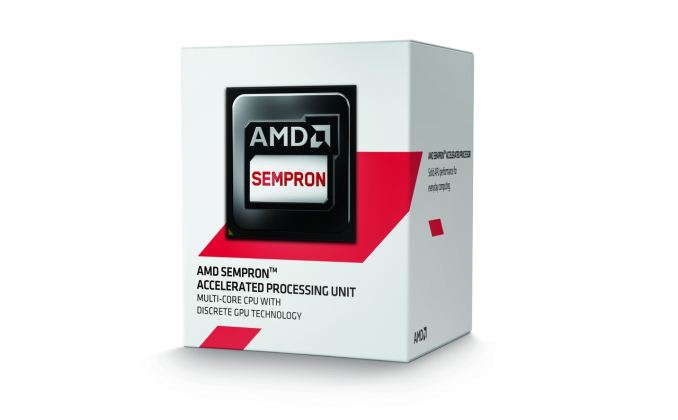
AMD announced earlier in March that it would be launching a socketed desktop Kabini APU. Traditionally the ultra low end/low power SoCs on desktops have come in packages soldered on to motherboards. If you need a faster CPU, you bought a new motherboard with it. With its new AM1 platform, AMD hopes to bring the sort of flexibility enjoyed by the rest of the desktop market to the entry level value segment.
The rationale is simple: the traditional desktop PC is under tremendous price pressure due to the popularity of affordable tablets, notebooks, Chromebooks and Chromeboxes. While there are definitely advantages to a desktop, it's a market that won't grow on its own. The one advantage desktops have over any of the aforementioned modern mainstream computing devices is upgradability. Unfortunately that's a feature that's often lost as we look at the value segment of the desktop market. AM1 attempts to fix that.
A socketed APU is useless without a lineup of APUs to swap in and out of the aforementioned socket, and that's exactly what AMD is launching today. There are a total of four AM1 APUs launching today:
| AMD AM1 Kabini APUs | ||||
|
Athlon 5350 |
Athlon 5150 |
Sempron 3850 |
Sempron 2650 |
|
| CPU Cores | 4 | 4 | 4 | 2 |
| CPU Frequency | 2.05 GHz | 1.60 GHz | 1.30 GHz | 1.45 GHz |
| GPU Cores | 128 | 128 | 128 | 128 |
| GPU Frequency | 600 MHz | 600 MHz | 450 MHz | 400 MHz |
| Memory Frequency | 1600 MHz | 1600 MHz | 1600 MHz | 1333 MHz |
| L2 Cache | 2 MB | 2 MB | 2 MB | 1 MB |
| TDP | 25 W | 25 W | 25 W | 25 W |
| Price | $55 | $45 | $36 | $31 |
Each of these APUs features up to four 28nm Jaguar cores and a 128 SP implementation of AMD's GCN GPU. We've gone over both the Jaguar and GCN architectures in previous articles, so we won't spend a lot of time recapping them here. Jaguar is the latest in AMD's line of "cat" cores, designed to go up against Intel's Atom. GCN on the other hand is a well known GPU design from AMD as well, cut down here to fit in a much smaller die area (and thermal envelope).
This isn't the first time we've seen this Jaguar + GCN combination of course. Kabini first launched as a notebook APU nearly a year ago. Architecturally we're looking at the very same SoC, even down to running at the same max clocks and at the same TDP. The big difference is what we have here today is socketed and targeted at the desktop.
The Athlon and Sempron brands are back and used for AM1 Kabini. The most expensive AM1 APU is the $55 Athlon 5350, a quad core SoC running at 2.05 GHz with a 2 compute unit GCN GPU (128 SP) running at 600 MHz. All four models will have an official TDP rating of 25W, suggesting that they are all the same die and merely binned according to performance.
While the APU costs are low, it's actually the motherboard costs that are most impressive. AMD expects mini-ITX and micro-ATX AM1 motherboards to retail for between $25 - $35. At the low end of the spectrum that means you could be looking at a fully integrated desktop platform for less than $60. Obviously you have to add in the cost of memory, storage, PSU/chassis and heatsink/fan but we're still dealing with an extremely low cost solution.
The real value in having a socketed processor is being able to upgrade the chip without incurring the cost of a new motherboard down the road. Unfortunately AMD isn't saying anything about what future APUs will support Socket-FS1b, so for now all we have is what's in the table above. Given the BGA compatibility between Kabini and Beema, I'd assume we might see a Beema FS1b upgrade at some point. However what comes after that remains to be seen.
Historically AMD has done a good job of maintaining backwards compatibility with sockets for as long as possible, the one challenge being shifts in memory technology. With DDR4 expected to ship at the high end later this year, the DDR3 based FS1b platform should at least have some life in it from a memory compatibility standpoint.
The Platform, Socket & Motherboards
While AM1 is the name of the platform, FS1b is the name of the new socket. AMD sent along a Gigabyte AM1 micro-ATX board (the GA-AM1M-S2H):
The AM1 platform makes for incredibly simple motherboards. There's hardly anything down on the board itself as Kabini is a full blown SoC with integrated memory, PCIe, USB, Gigabit Ethernet and SATA controllers. Gigabyte threw down an iTE Super I/O chip on the motherboard (beneath the heatsink in the lower left) to add serial, LPT, and PS/2 keyboard/mouse ports.
The key points to note here are:
- Single Channel 64-bit DDR3/DDR3L
- Two USB 3.0
- Eight USB 2.0
- PS/2
- Trusted Platform Module Support
- Up to four eDP/DP/HDMI video ouputs
- VGA output
- Four PCIe 2.0 lanes for a discrete GPU/PCIe device
- Two SATA 6 Gbps ports
- One PCIe 2.0 x1 lane allocated to an Ethernet controller
- Three PCIe 2.0 x1 lanes for other controllers (SATA, USB, LAN, WiFi, PCIe 2.0 x1 slots, PCIe to PCI bridges)
As you can see, Kabini provides a good amount of IO. The Gigabyte board includes a single PCIe x16 slot (x4 electrical) and two x1s. You also get two USB 3.0 ports and two USB 2.0 ports on the back header, although the APU itself can support up to 8 USB 2.0 ports. There are also two 6Gbps SATA ports down on the board, the maximum supported by Kabini.
The audio solution has to be cheap to be viable, and we get an ALC887 Realtek codec, which is actually higher end than I expected. Realtek are said to offer a discount when an audio codec and network controller are bought for the same product, so it is no surprise to see a Realtek NIC equipped here.
Because AM1 is a drive to low cost platforms, I do not see many motherboard manufacturers taking advantage and producing works of electrical engineering art. When the most expensive APU you can purchase for a platform is $55, when a motherboard manufacturer starts considering extra controllers or fancy features, the cost/benefit analysis might go out of the window. An extra USB 3.0 controller might add $0.75 to the bill-of-materials, require extra validation and optimization, then add a final $2.50 to the end-user cost (or $4 after retailer markup). After speaking with Patrick from ServeTheHome about the platform, there is certainly scope for adding several NICs to the motherboard and combining its use both as a PC and a router, however none of the motherboards being released with AM1 at launch seem to have more than one.
I was told by AMD that AM1 systems should support memory overclocking above the verified DDR3-1600 speed. This should allow the integrated graphics to stretch its legs a bit more despite the presence of a single channel memory controller should a system integrator consider buying faster memory. Unfortunately at least the Athlon 5350 seems locked to a max multiplier of 20.5x, so there's no hope for easy overclocking of this part at least.
On day one, motherboards should be available from the following vendors:
Once the products are in the market we will attempt to go over them all in one of our motherboard previews, and perhaps a few in full reviews.
With a new socket comes a new heatsink mounting system. Although the rest of AMD's desktop sockets still rely on a latch + lever retention system, Socket-FS1b moves to a push-pin design similar to what Intel uses on its motherboards (albeit with fewer mounting holes, and much simpler mounting/removing due to lower retention force requirements).
At 25W TDP, we might have been hoping for a passive solution, and I am sure that one of the CPU cooler manufacturers will make one, but AMD is playing it safe by using a small active low profile stock cooler. I would hazard a guess that this is an all aluminium construction in order to keep costs down. The reference AM1 HSF is oddly reminiscent of what old "high end" CPUs used to use years ago.
Most AM1 platform motherboards will be similar to what we have here. Some will ship with DisplayPort/DVI, and others might have an extra USB3/SATA controller. I doubt we will see any with audio codecs above the ALC892, or Killer NICs, although there might be an Atheros in the mix.


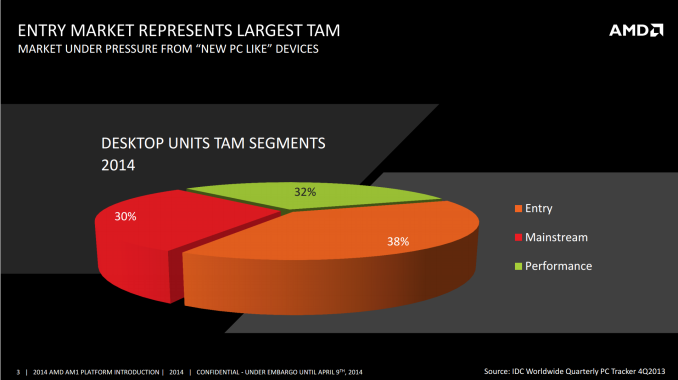
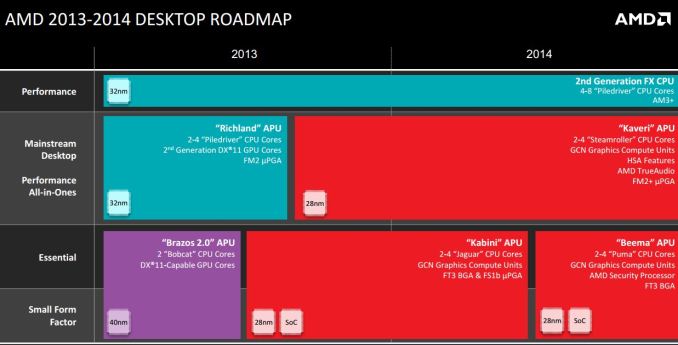







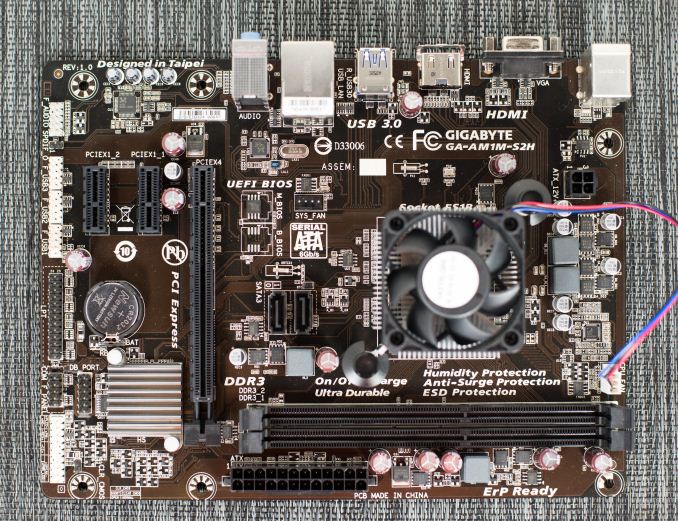
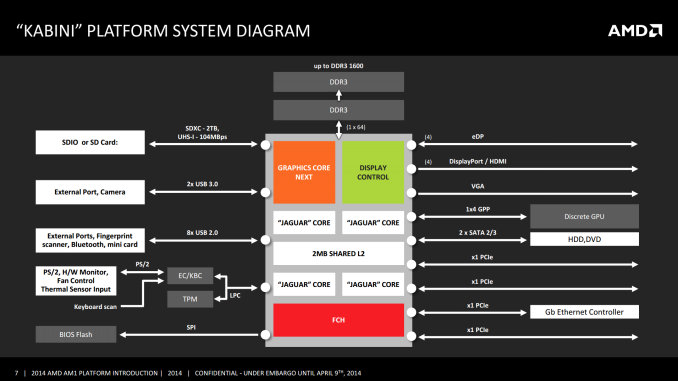
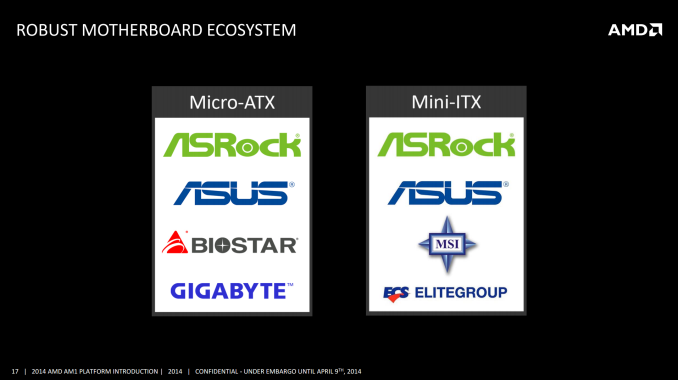
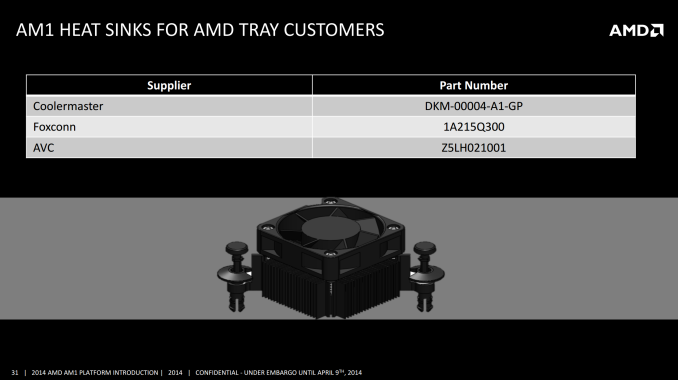
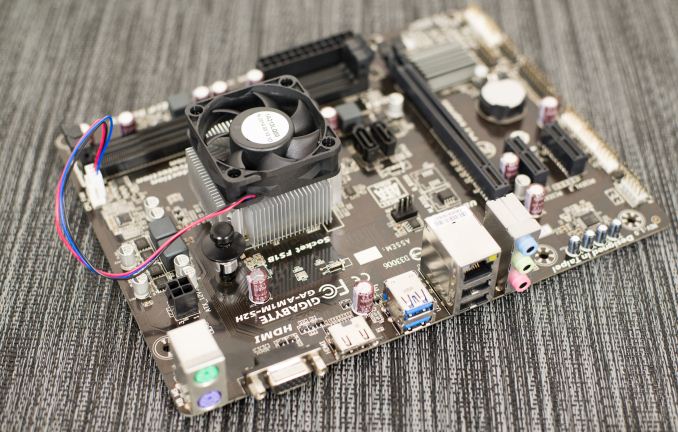
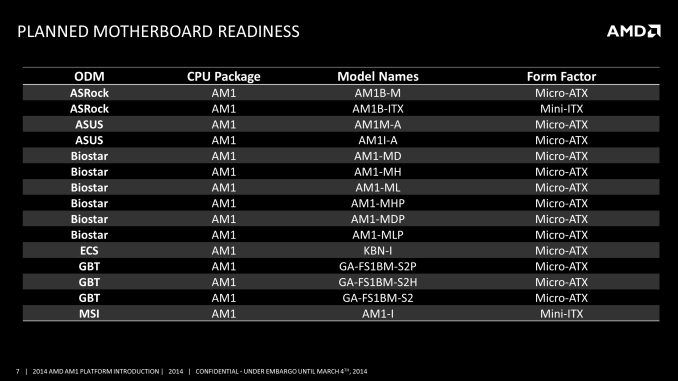








126 Comments
View All Comments
ozzuneoj86 - Wednesday, April 9, 2014 - link
I do hope that all of this works out for AMD. It seems like a pretty huge gamble to invest so much time and energy into creating a new socketed platform. I do like the idea of tiny yet powerful systems, for sure. I built a Pentium 4 based mini-ITX system that won Maximum PC's rig of the month in July 2007, since there were relatively few ITX systems available at the time. This was pre-Atom, so you were either spending $300+ on a board that took an equally expensive Core-based laptop CPU, or you were going with a Via C7 or some other abysmally slow chip built into a board that still cost $200. Our grand total for the whole project was under $500.That system is socketed, but with Intel Extreme 2 graphics (before GMA) and only a PCI slot to work with, there was only so much it could be used for. It handles emulators perfectly fine though.
Anyway, I just hope they hang on to this platform for a while so that it makes sense for it to be socketed. Looking at the CPU options available, it doesn't look like it offers a huge range of possibilities. They are all quite firmly seated in the low end of performance and aren't all that power efficient. I could see a low end platform being useful if they offered significantly different combinations of CPU power, GPU power and wattages, but I'm not really seeing that with these.
ozzuneoj86 - Wednesday, April 9, 2014 - link
For clarification, by "not all that power efficient" I mean the TDP, when compared to Intel's non-socketed chips. These are still fairly low wattage, but you can't exactly stuff one of these in a cigar box and run in passively cooled.Also, any chance we could get a Celeron 1037u system benchmarked as well? I'm curious as to how the CPU\GPU performance compares to the J series, as well as Kabini. http://ark.intel.com/products/71995
Hardened - Thursday, April 10, 2014 - link
I woul like to support request for comparison with Celeron 1037U. It is a very interesting CPU performance and cost wise. Gigabyte GA-1037UN mobo is also a very nice offer with 2x LAN and eSATA ports all under 90 USD.Computer Bottleneck - Wednesday, April 9, 2014 - link
Do we know if any manufacturers will be supporting ECC RAM on these boards? Or any upcoming AM1 boards?According to CPU World Athlon 5350 does indeed support ECC:
http://www.cpu-world.com/CPUs/Jaguar/AMD-Athlon%20...
TheCrustyCupcake - Wednesday, April 9, 2014 - link
Water cooled AM1 socket-ed APU's anyone? If overclocking was available I could see an EVGA super ultra FTW edition AM1 motherboard with an 8-pin supplemental CPU power connector, and crossfire support!DudemanX - Wednesday, April 9, 2014 - link
In part 2 and in future articles when reviewing IGPs, can you do some game benchmarks at more mainstream resolutions(1680, 1920, maybe even 1440) but with "Low" quality settings? Many might disagree but not running my display at native resolution is one of the last compromises I make when using inadequate hardware. I understand these aren't mainstream chips but they are desktop/media center chips. Do people really buy desktop monitors/TVs lower than 1680 these days? Certainly no one's running games in 4:3 anymore, are they?mariush - Wednesday, April 9, 2014 - link
I just don't understand why they don't make the boards for these systems to run on 12-19v laptop adapter type power supplies.It's really not that expensive to add a dc-dc converter on the motherboard to make 5v for the sata drives and onboard stuff... no, we still have to use a big fat 24pin atx cable AND a 4 pin cpu cable for a system that uses 30-60 watts (without a powerful video card).
srkelley - Wednesday, April 9, 2014 - link
Can you post some modified benchmarks of the gaming performance please? I'm interested in seeing the average frame rate of the same games but run with Medium settings at 1280x720 please. It doesn't need to be in a fancy chart or done completely scientifically, just a few numbers would be helpful!shady28 - Thursday, April 10, 2014 - link
Great review, this helps clear up some questions regarding AM1.Suggestion for your follow up -
If possible, show more of the chips this succeeds and that it competes against.
ie :
J1800, J1900, 3770, and some of the older Atoms like D525 or D510.
It would also be interesting to see a couple of older reference desktop, like a P4 D chip. For some this would help answer the question, is this a viable upgrade for someone who wants a small low power replacement for an old power hog of a P4?
The obligatory i5-2500k or i5-3570k is fine, but stacking up a huge number of 100W chips in the comparison doesn't help, it just clutters up the charts with products that in no way compete with something like Kabini.
Penti - Thursday, April 10, 2014 - link
So it's a Kabini/Jaguar fabbed at Global Foundries in Germany? Why?